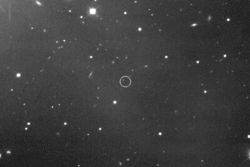Tarvos (moon)
Topic: Astronomy
 From HandWiki - Reading time: 3 min
From HandWiki - Reading time: 3 min
 Animation of discovery images taken by the CFHT in September 2000 | |
| Discovery[2] | |
|---|---|
| Discovered by | B. J. Gladman et al.[1] |
| Discovery date | September 23, 2000 |
| Designations | |
Designation | Saturn XXI |
| Pronunciation | /ˈtɑːrvɒs/ |
| Named after | Tarvos Trigaranus |
| S/2000 S 4 | |
| Adjectives | Tarvian[3] |
| Orbital characteristics[4] | |
| Epoch 2000 Feb. 26.00 | |
| 17.983 Gm | |
| Eccentricity | 0.5305[4] |
| Orbital period | 926.2 d (2.63 yr) |
| Inclination | 33.825 |
| Satellite of | Saturn |
| Group | Gallic group |
| Physical characteristics | |
| Mean diameter | 15+50% −30% km[5] |
| Rotation period | 10.691±0.001 h[5] |
| Albedo | 0.04[6] assumed |
Spectral type | light red B−V=0.0.77, R−V=0.57[7] |
Tarvos /ˈtɑːrvɒs/, or Saturn XXI, is a prograde irregular satellite of Saturn. It was discovered by John J. Kavelaars et al. on September 23, 2000, and given the temporary designation S/2000 S 4. The name, given in August 2003, is after Tarvos, a deity depicted as a bull god carrying three cranes alongside its back from Gaulish mythology.[8]
Orbit
Tarvos orbits Saturn at an average distance of 18 million km in 926 days and is about 15 km in diameter (assuming an albedo of 0.04). It has a high orbital eccentricity of 0.53.[4]
It is a member of the Gallic group of irregular satellites.
Origin
With a similar orbit and displaying a similar light-red colour, Tarvos is thought to have its origin in the break-up of a common progenitor[7][9] or to be a fragment of Albiorix.[10]
References
- ↑ MPEC 2000-Y14: S/2000 S 3, S/2000 S 4, S/2000 S 5, S/2000 S 6, S/2000 S 10 December 19, 2000 (discovery and ephemeris)
- ↑ Discovery Circumstances (JPL)
- ↑ Per the diminutive Tarvillus in Daniel Davis (2001) The Development of Celtic Linguistics, 1850-1900, p. 162
- ↑ 4.0 4.1 4.2 Jacobson, R.A. (2007) SAT270, SAT271 (2007-06-28). "Planetary Satellite Mean Orbital Parameters". JPL/NASA. http://ssd.jpl.nasa.gov/?sat_elem#saturn.
- ↑ 5.0 5.1 Denk, T.; Mottola, S. (2019). "Cassini Observations of Saturn's Irregular Moons". 50th Lunar and Planetary Science Conference. Lunar and Planetary Institute. https://www.hou.usra.edu/meetings/lpsc2019/pdf/2654.pdf.
- ↑ Scott Sheppard. "Saturn's Known Satellites". Department of Terrestrial Magnetism. http://www.dtm.ciw.edu/users/sheppard/satellites/satsatdata.html.
- ↑ 7.0 7.1 Grav, Tommy; Holman, Matthew J.; Gladman, Brett J.; Aksnes, Kaare; Photometric survey of the irregular satellites, Icarus, 166 (2003), pp. 33–45
- ↑ IAUC 8177: Satellites of Jupiter, Saturn, Uranus August 8, 2003 (naming the moon)
- ↑ Gladman, B. J.; Nicholson, P. D.; Burns, J. A.; Kavelaars, J. J.; Marsden, B. G.; Holman, M. J.; Grav, T.; Hergenrother, C. W.; Petit, J.-M.; Jacobson, R. A.; and Gray, W. J.; Discovery of 12 satellites of Saturn exhibiting orbital clustering, Nature, 412 (July 12, 2001), pp. 163–166
- ↑ Grav, Tommy; and Bauer, J.; A deeper look at the colors of Saturnian irregular satellites
- Ephemeris IAU-MPC NSES
External links
 |
 KSF
KSF

